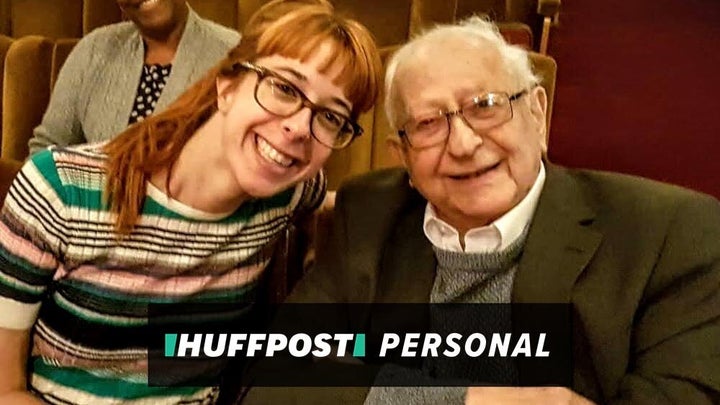
On 25 March, I watched a livestream of my grandpa’s burial.
It felt perverse and inappropriate, and all the more so because it felt so familiar. I’ve attended more than ten funerals at that same cemetery, where the majority of the local Jewish community I grew up in reserve burial plots.
This time, my view was through the rabbi’s phone. I recognised the waiting area with sinks for ritual hand washing (now serving a dual purpose), and the outdoor archway where the congregation gathered behind the coffin as the rabbi chants El Male Rachamim – a mournful prayer for the soul of the deceased. I was there, following the coffin on a five minute walk to the graveside as I’ve done so many times before, but my legs were still. I could hear birds singing somewhere above the rabbi’s head, the sound usually obscured by the shuffling of feet on the pavement beside me.
At most, my family are selectively observant of Jewish rituals – but we always do death and mourning ‘properly’. When we gathered around my grandpa’s hospital bed to say goodbye, knowing there was nothing more that could be done to treat him, my mum read psalms to herself as prescribed by a rabbi, and said the Shema prayer aloud so my grandpa could hear it as he neared the end, in line with Jewish tradition.
That evening we found out my grandpa had somehow caught coronavirus in hospital. We immediately quarantined in our separate homes while grandpa slipped in and out of consciousness, now alone. Within 24 hours my mum was sick, and the rest of us succumbed to the virus gradually in the following days.
“We hadn’t expected that we would all be confined to our homes. It was as if some external power was playing the cruelest trick on us.”
We expected that our mourning rituals would have to be adapted in the time of covid-19, but this was a week before the government announced any formal lockdown measures. In our minds, we’d still be able to perform all the important rituals in person – but among only immediate family. We hadn’t expected that we would all be confined to our homes. It was as if some external power was playing the cruelest trick on us.
Jewish practices around death and mourning demand intimacy and presence. From death to the burial, the body must be ‘guarded’ by another person in the room – typically immediate family, who swap in and out of this duty. The funeral must take place as soon as practically possible and requires a minyan – quorum of ten people physically present – in order to say the Kaddish mourning prayer. The mourners and supporting congregation physically bury the coffin themselves, taking turns to shovel earth until the hole is filled. The rabbi ceremoniously tears the clothing of each mourner, and they continue to wear the torn garment throughout the following week of mourning, called a Shiva.
Every evening family and friends gather at the home of one of the mourners for prayers and support, and the night always ends the same way: casual chit-chat while drinking cups of tea. At the end of the week, mourners are symbolically (and physically) pulled out of the special mourning chairs, which sit very low to the ground, and walk around the neighbourhood. This strict and familiar schedule helps us confront our loss in a way that feels manageable. Without it, I fluctuated between despair and detachment.
“Livestreaming the burial was distressing, but important as a proxy for the usual rituals. If we couldn’t partake in the funeral, at least we could witness it.”
Livestreaming the burial was distressing, but important as a proxy for the usual rituals. If we couldn’t partake in the funeral, at least we could witness it. The virtual shiva week of mourning served a greater purpose, allowing us to proactively take some control to commemorate grandpa. It was an antidote to the helplessness I felt, like a tool to break through the walls confining me to isolation.
Unexpectedly, the virtual nature of these evening rituals added a new dimension to our communal mourning, rather than diluting it. While we couldn’t say the Kaddish mourning prayers which are only allowed in the presence of the community, we found new ways to express our love for grandpa and what his loss meant. One evening my cousin played a recording of grandpa, aged 80, singing Sinatra’s New York, New York. On the final night, I used Zoom’s screen sharing feature to present a slideshow of family photos.
But the most powerful part of the shiva week was an entirely new ritual that emerged naturally. To replace the in-person greeting line, where community members simply wish each mourner the traditional message of condolence before quickly moving on, we unmuted participants on the Zoom call one-by-one to say a few words. Every night people shared personal reflections, messages of support, memories of grandpa, and unmediated expressions of the pain covid-19 was inflicting. In person, these greetings are short and private, but on Zoom everyone listened as each person spoke.
I’ve known everyone there my whole life, but in these moments I felt closer to them than ever before. Somehow, the technology, coupled with our desperate need for connection during social distancing, transformed our mourning process into even more of a communal and interconnected experience.
Carly Minsky is a freelance science and technology journalist. Follow her on Twitter at @carlyminsky
Have a compelling personal story you want to tell? Find out what we’re looking for here, and pitch us on ukpersonal@huffpost.com